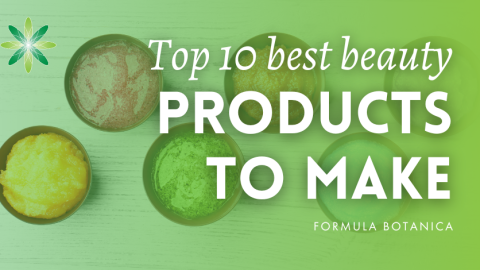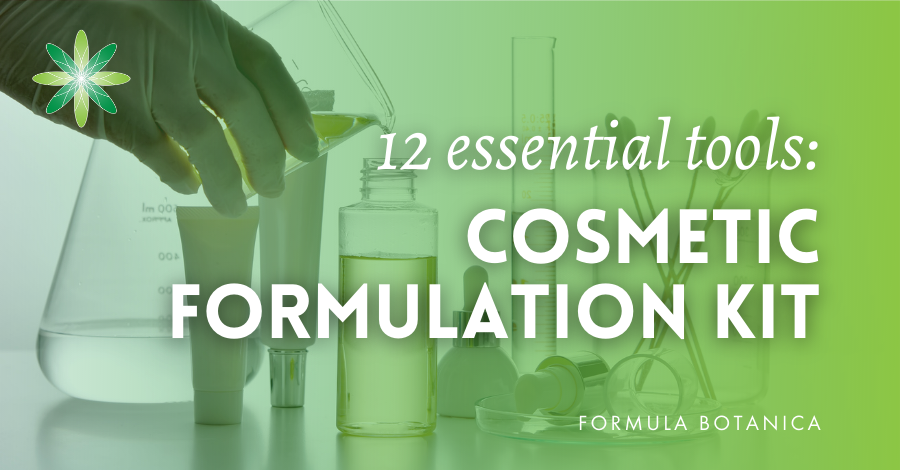Whether you are a budding formulator or someone with experience under their belt, making a whipped body butter is fun and a relatively easy formulation to master. In this post, we bring you an anhydrous formula (it contains no water) for a whipped body butter that has a cream-like texture and is ideal as body moisturiser.
It is a perfect DIY skincare formulation if you are just starting out making cosmetics at home. It is also an ideal formulation to make if you wish to avoid using any preservatives in skincare.
This whipped body butter recipe creates a wonderful product equally suited to summer and winter, although you may prefer to vary the butters, oils and scents for the different seasons.
Whipped body butters contain mainly butters and oils, but in a hotter climate you may also want to add some wax. We didn’t do that in this formula simply because the weather was not too hot in the UK when we created our formula for the video tutorial. If you do add a wax though, pay attention to the amount you add otherwise you will end up with a greasy mess that drags on the skin. See our post on 5 vegan waxes for organic skincare formulations for some inspiration on which to choose.
To really spice up this whipped body butter, you can layer it with botanical extracts and essential oils as well. As always, adapt our formula to your preferences or to fit in with the skincare theme you are working on.
If you enjoy this formulation, you might like to see some other easy-to-make anhydrous cosmetics we’ve covered:
How to make an organic pressed serum
How to make a whipped lip scrub
How to make a day facial oil
How to make a nourishing hand balm
We also looked at how anhydrous cosmetics are trending for all sorts of reasons in our post on the myth of waterless beauty.
Make a whipped body butter with tuberose & neroli
Our formula
We are using a butter which has been a secret favourite for a while: Tacuma or Tucuma butter. It from the Amazon region, and is high in lauric and myristic acids. It’s a perfect addition to products for dry skin and dry hair as well. Here, we paired it with some mango butter and coconut oil. If you’d like to discover some other butters from South America, see our post on five Amazonian butters.
We are aiming to make a whipped body butter with a slightly drier skin feel so we we added also some coco-caprylate. It’s an emollient which can be used to replace the synthetic cyclomethicone in formulations. It gives a lovely slip and dry feel that is a silicone-like feel. The result is a velvety, fast-absorbing butter, but of course your product might vary if you have used other ingredients.
We decided to add some alkanet-infused rice bran oil which gave that subtle pink hue to our butter. Take a look at our post on how to make macerated oils if you’d like to experiment giving your body butter an extra botanical boost with some amazing, colourful extracts.
The essential oils: scent and benefits
The tuberose and neroli essential oil combination, a floral yet subtle aroma, works very well with the coconut scent detectable in the body butter. Tuberose (Agave amica, formerly Polianthes tuberosa) is a night-blooming plant, native to Mexico.
It is mainly used in perfumery for its gorgeous scent, and less often in aromatherapy simply because of the costs. Its floral, slightly earthy scent is said to be calming. You only need to use a little in your formulation and for that reason, in this formula, we used a more affordable version as a 5% dilution in jojoba oil. Tuberose works well with other floral scents so we chose neroli.
Tisserand: Essential Oil Safety guide recommends a dermal limit of tuberose of 1.2%, given that it contains methyl eugenol, which is a skin sensitiser found in some essential oils. Tuberose extracts obtained through CO2 extraction or solvent extraction have been found to be antimicrobial (i).
Neroli essential oil is a very fragrant oil from bitter orange tree blossoms. It is often used in perfumery, aromatherapy and in skincare as well and is said to enhance mood, be useful for oily skin and to calm red, irritated skin. Research shows it has both antimicrobial and antioxidant activities (ii). According to Battaglia: The Complete Guide to Aromatherapy, it is recommended for use on all skin types and may be useful in products with skin rejuvenating purpose.
Start making cosmetics at home with this whipped body butter recipe featuring tuberose & neroli. Learn more about online #cosmeticscience courses @formulabotanica #naturalskincare #skincarecourse Share on X
Ingredients
Phase A
Tacuma butter: 40%
Mango butter: 20%
Coconut oil: 10%
Phase B
Coco-caprylate: 15%
Alkanet infused rice bran oil: 8.40%
Phase C
Tuberose absolute (5% dilution in jojoba oil): 0.30%
Neroli essential oil ( 5% dilution in almond oil): 1.20%
Rosemary CO2 extract: 0.10%
Phase D
Micronised Rice powder: 5%
Method of Manufacture
See also our video tutorial above.
- Melt the butters (Phase A) in a bain marie.
- Weigh the oils in another beaker.
- When the molten butter is a bit cooler, add the oils and stir well. Set aside.
- Weigh the essential oils and the antioxidant (Phase C).
- Add them to the butter/oil blend.
- Place in the fridge so it thickens up a bit. You need to do this as we are adding rice powder. If you add the rice powder while the blend is too liquidy, the powder will just sink to the bottom of the mixture.
- Stir the blend regularly to ensure even cooling. When you see a trace, add the rice powder and stir it well to get rid of any lumps.
- You can now start whipping. Place butter in the fridge for 5-10 mins and whip it again.
- You can do this 2-3 times until you reach a light and fluffy consistency.
- Transfer it into a pretty jar and leave it in the fridge for the night.
- You will see that the butter will harden a bit.
Now it is your turn to make your own whipped body butter. Leave us a comment below to tell us how you got on and if you customised our formula with your own choice of butters and scents.
If you want to learn more about how to make body butters and other fantastic facial and body skincare products, check out our Diploma in Organic Skincare Formulation. Have you pre-registered yet? Just sign up to stay informed about all our organic skincare formulation courses. In the meantime, try out a sample class to find out more about learning with Formula Botanica.
If you’ve been formulating for a while and are considering starting your own beauty brand, check out our brand new Diploma in Beauty Brand Business Management.
References:
(i) Ghosh, P.K., Bhattacharjee, P, Das, S. 2013. Antimicrobial activity of supercritical carbon dioxide extracts of tuberose (Polianthese tuberosa Linn.) flowers against common pathogens. IJPSR, 2014; Vol. 5(4): 1279-1289
(ii) Chemical composition and in vitro antimicrobial and antioxidant activities of Citrus aurantium L. Flower Essential Oil (Neroli Oil). Pakistan Journal of Biological Science. 15 (21): 1034-1040, 2012. ISSN 1028-8880.
Suggested Suppliers
Tacuma butter
UK: Akoma Skincare
Sheabutter Cottage
USA: Rainforest Chica
Coco-caprylate
UK: The Soap Kitchen
EU: Aroma-Zone
USA: Formulator Samples Shop
Tuberose absolute
UK: Quinessence
USA: Eden Botanicals ( very pricey as not diluted)
FAQs
How do you make a whipped body butter less greasy?
Natural body butters are typically formulated with rich, emollient plant oils, butters and waxes. Depending on the chosen ingredients, some body butters may feel heavy, overly rich and greasy. If you wish to formulate a body butter at home that is less greasy and absorbs faster on the skin, try substituting part of the oils with ligher, natural and nature-identical esters and lipids such as coco-caprylate which has a nice skin feel similar to that found in synthetic ingredients and silicons. If you desire a matte effect and less greasiness, try cosmetic grade starch powders such as rice powder or corn starch which need to be added in the cool-down phase to ensure they blend in evenly across the product.
What is a whipped body butter for?
Natural body butters are created from the blending of molten plant oils, butters and waxes along with scent and starch powders. They are melted, blended and poured into containers to cool. A whipped body butter goes through several stages of whipping during the cooling down process to incorporate pockets of air into the cosmetic. The whipping creates a lighter, fluffier body butter with often a far less heavy and greasy skin feel.
Where can I learn to formulate natural skincare and haircare?
Join us at Formula Botanica, where tens of thousands of students and followers take our free and paid online courses to learn how to formulate organic skincare and haircare for themselves or to sell and also how to set up a beauty brand and business.
Leave us a comment

Timi was a key member of the Formula Botanica team from 2015 to 2020; first as our Education Manager and then as Head of Formulation & Research. You can find out more about the Formula Botanica team here.





























